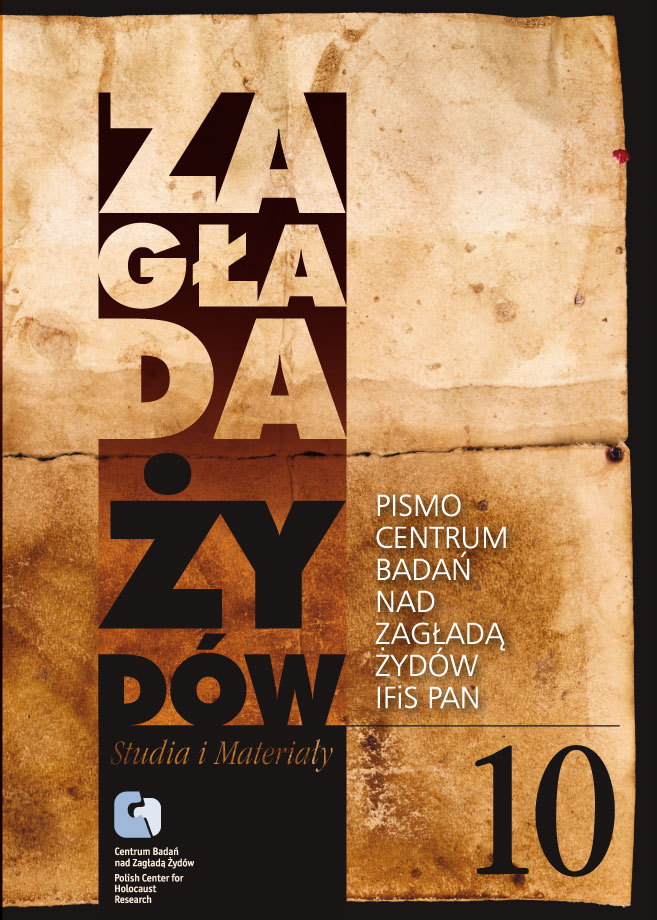Instead of Negationism. Symbolic typography of the area of the former Warsaw Ghetto and narratives about the Holocaust
Zagłada Żydów. Studia i Materiały, No. 10 (2014), Pages: 209-256
Submission Date: 2020-10-22Publication Date: 2014-12-01
 https://doi.org/10.32927/ZZSiM.522
https://doi.org/10.32927/ZZSiM.522
Abstract
A comparative analysis of the two monuments erected on one of the streets in the area of the former Warsaw Ghetto — the Umschlagplatz monument (1988) and the Monument to the Fallen and Murdered in the East (Pomnik Poległym i Pomordowanym na Wschodzie) (1995) — shows how the equation of Nazism with Stalinism, if not with communism, has become inscribed in the symbolic topography of that place. The stake in this operation is the holocaustisation of the “Polish fate,” epitomised by deportations into the interior of the USSR and the massacre in Katyń. The anticommunist discourse with a still undefused anti-Semitic potential (the myth of Judeo-communism, the double genocide theory) constitutes the overall narrative framework. The result is the rationalisation (presentation as a well deserved punishment or self-defence) of the stances of the majority of the Polish society and its behaviour toward Jews during the Holocaust. Instead of upsetting the heroic-martyrologic narratives about the dominant group’s past, the increasing knowledge about the facts leads only to their mutation and strengthening. The context of this phenomenon is the politics of memory adopted by Poland and the Baltic states on the European forum. Its dynamic consists in shifting the limits of the European memory compromise, that is, in rationalisation of the Holocaust and anti-Semitism in an attempt to preserve one’s image as the hero and victim.
Keywords
symbolic topography , politics of memory , double genocide theory , holocaustization , anti-Semitic discourse , myth of Judeo-communism , Warsaw Ghetto , Katyń , monuments in the area of the former Warsaw Ghetto , Katarzyna Kobro’s theory of spatial composition , Zofia and Oskar Hansen’s Open Form
License
Copyright (c) 2014 Author&"Holocaust Studies and Materials"

This work is licensed under a Creative Commons Attribution 4.0 International License.
https://creativecommons.org/licenses/by/4.0
The journal is published under the Diamond Open Access Standard, CC-BY-4.0 Deed - Attribution 4.0 International - Creative Commons
Similar Articles
- Elżbieta Janicka, Instead of negationism. The symbolic topography of the former Warsaw ghetto vis-à-vis Holocaust narratives , Zagłada Żydów. Studia i Materiały: No. Holocaust Studies and Materials (2017)
- Jacek Leociak, Anniversaries of the Warsaw Ghetto Uprising in public discourse (with special reference to the years 1943–1944, 1968 and 2023) , Zagłada Żydów. Studia i Materiały: No. 19 (2023)
- Katarzyna Chmielewska, Multidirectional and agonic memory vs. politics of memory , Zagłada Żydów. Studia i Materiały: No. 17 (2021)
- Andrzej Czyżewski, The Marginalized, Unwanted, and Silent Memory… – Łódź Ghetto in Communist Poland’s Politics of Memory , Zagłada Żydów. Studia i Materiały: No. 16 (2020)
- Marta Duch-Dyngosz, In Search of Local Memory of the Holocaust. The Case of Commemoration of Jewish Communities in Smaller Towns in Contemporary Poland , Zagłada Żydów. Studia i Materiały: No. 17 (2021)
- Sylweriusz B. Królak, Strolling in the Ghetto. Experience of the Space of the Łódź and Warsaw Ghettoes from a Pedestrian’s Perspective , Zagłada Żydów. Studia i Materiały: No. 16 (2020)
- Gabriel Finder, Bernard Mark, the Uprising in the Warsaw Ghetto, and Jürgen Stroop’s Trial , Zagłada Żydów. Studia i Materiały: No. 13 (2017)
- Katarzyna Person, Jürgen Stroop Speaks: The Trial of the Warsaw Ghetto Uprising Liquidator before the Warsaw Provincial Court , Zagłada Żydów. Studia i Materiały: No. Holocaust Studies and Materials (2013)
- Adam Kopciowski, Pinkes Warsze - Warsaw Chronicle , Zagłada Żydów. Studia i Materiały: No. 10 (2014)
- Dariusz Libionka, Adam Kopciowski, The Life and the Holocaust in Hrubieszów in the Eyes of a Young Woman from Warsaw , Zagłada Żydów. Studia i Materiały: No. 3 (2007)
1 2 3 4 5 6 7 8 9 10 11 12 13 14 15 16 17 18 19 20 21 22 23 24 25 26 27 28 29 30 31 32 33 34 35 36 37 38 39 40 41 42 43 44 45 46 47 48 49 50 > >>
You may also start an advanced similarity search for this article.
 English
English
 Język Polski
Język Polski



 https://orcid.org/0000-0002-0945-6886
https://orcid.org/0000-0002-0945-6886

